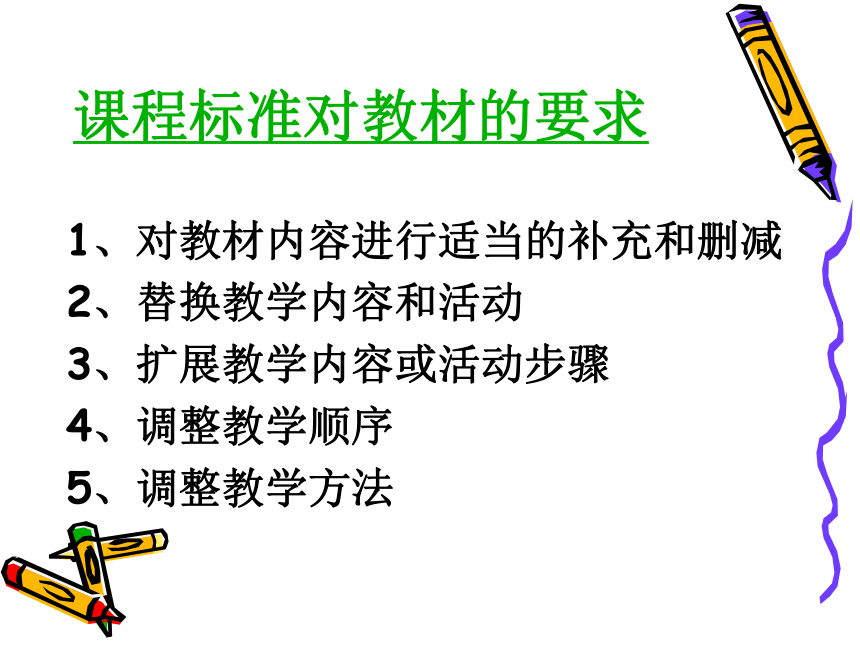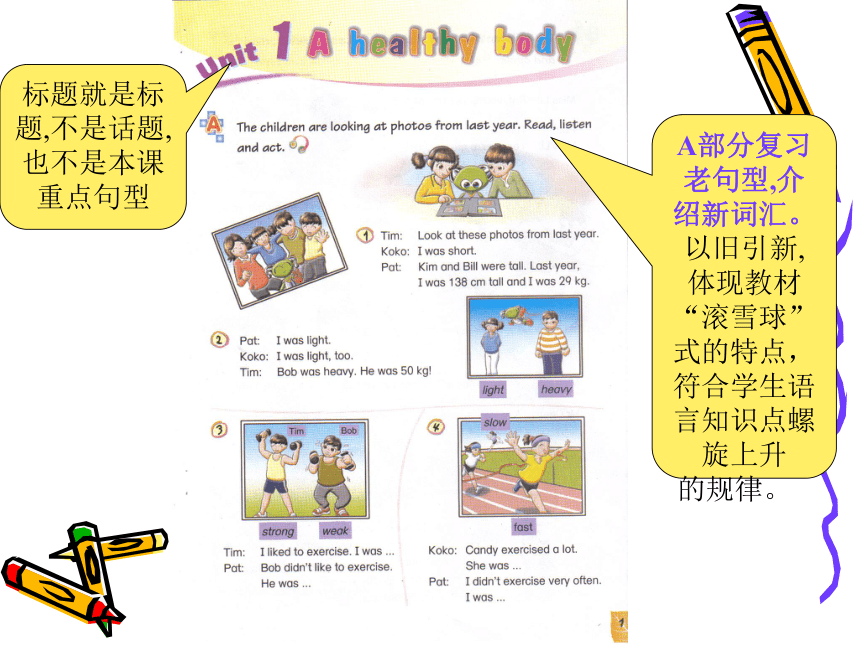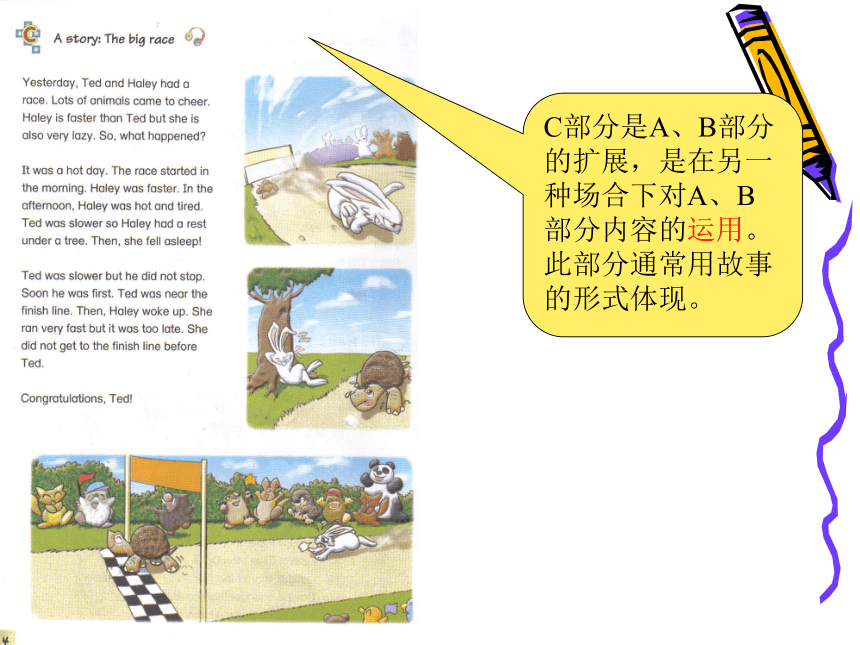小学英语深港版六年级上册book 11(textbook analysis)
文档属性
| 名称 | 小学英语深港版六年级上册book 11(textbook analysis) |  | |
| 格式 | rar | ||
| 文件大小 | 11.7MB | ||
| 资源类型 | 教案 | ||
| 版本资源 | 深港版 | ||
| 科目 | 英语 | ||
| 更新时间 | 2009-03-30 18:45:00 | ||
图片预览












文档简介
课件60张PPT。Primary English For ChinaBook 11课程标准对教材的要求1、对教材内容进行适当的补充和删减
2、替换教学内容和活动
3、扩展教学内容或活动步骤
4、调整教学顺序
5、调整教学方法
教师对教材认识的转变以往教师是教教材,因此深挖教材细节和知识点,教学生知识。因为教什么考什么。
如今教师要利用教材教方法、培养学生终身学习的习惯和能力,因此教师应把教材当作参考,当作一个线索,一个系统,利用它作为参照物,教学习方法,养成习惯,提高能力,学到知识。因为现在考试是考能力。教材结构(体例) 整体设计(Overall plan) 1)? 语言功能(Functions)是根据《课程标准》中语言
知识部分制定的功能意念,是语言功能的体现 2)? 语言重点(Language Focus)是根据《课程标准》中
语言知识部分制定的语言结构(包括语法项目) 3)? 主题词汇(Topic Vocabulary) 是课文中要求必须掌握
的词汇
4)? 任务(Tasks)是根据《课程标准》中目标描述部分制
定的要达到的目标学生用书目录正课教材中的三个主要人物复习课文化单元图片词典剪贴页词汇表全家福标题就是标题,不是话题,也不是本课重点句型A部分复习老句型,介绍新词汇。以旧引新,体现教材“滚雪球”式的特点,符合学生语言知识点螺旋上升
的规律。B1部分是在有意义(meaningful)的情景中呈现本课的新句型并结合A部分的单词进行的操练。这部分是本课的重中之重。B2是本课主要句型的操练和运用(use),是B1的延伸。本课主要知识点(新单词、新句型)的听力检测,和J部分(本课主要知识点的书面检测)相互呼应。C部分是A、B部分的扩展,是在另一种场合下对A、B部分内容的运用。此部分通常用故事的形式体现。D部分是对C部分的理解程度的检测。E部分是语音练习,教给学生单词拼写的规律,是课标学习策略方面的体现。
F部分是一个语言任务,要求学生根据前面学习的内容的内容,用语言解决实际生活中的问题,是本课学以致用的部分。
G部分是以song或chant的形式巩固和进一步掌握本课的主要内容,提高学生的学习兴趣。此部分是与本课有关的知识性或脑筋急转弯的题目,需要学生开动脑筋,主要是开拓学生视野,培养学生用英语思维的能力。此部分是拓展阅读,目的是增加学生的阅读量,扩大他们的知识面,了解各国文化差异,从而提高他们的阅读能力和水平。此部分是对前面所学内容的书面检测,让学生对自己的学习效果进行监控,是每单元最后一项内容。
每册书的4和8单元是复习课为体现自主学习A部分是学生自己对前面所学内容的总结,其中不仅包括课本上的东西,还包括课外的东西。B部分是单元检测,是对前三课学习内容的总结。是听的检测。C部分是用另外一种场景对所学的知识进行应用。是对说的检测。D部分是阅读检测,检测学生的阅读能力是否有所提高。此部分检验学生写的能力。占两页。此部分检验学生写的能力。占两页。课时安排:本学期共有授课时间大约19周,2周左右总复习时间。每个unit用9个课时,每个复习课用5个课时及每个测试1个课时,讲解1个课时,共约74课时。第一课时:A
第二课时:B1 +G
第三课时: B2, B3
第四课时:复习前面部分+F第五课时: CD
第六课时:E+复习读音规则+本课练习
第七课时: I
第八课时: 复习+H, J
第九课时:练习
全册教学内容的架构Unit 1 A healthy body (单音节词比较级--er)
Unit 2 The natural world(单音节词最高级--est)
Unit 3 Space (unit1+2 扩展 much+--er, one of the--est)
Unit 5 Faster, higher and stronger (使用better, best,
more, most 表示好和数量的比较 )
Unit 6 Famous stories(多音节词的比较级和最高级)
形容词的比较级和最高级
Unit 7 International food
连词---向语篇扩展 (complete, clear, coherent)
(2, 3, 6,7 最具实用性)创情景:词汇和句型在有意义的情境中反复出现,能为学生提供多次认识和体验语言的机会。
活动多样有层次:识记、背诵、观察比较事物之间的异同(spot the differences)、将具有共同特点的东西归类列表(make a list)遵循小学生语言学习的规律Meaning
Use
FormReadingWhat? Who? When? Where? Why?How?
Pre-reading: Look at the pictures and guess what the passage is going to talk about. Then raise specific questions about the passage.
While-readingLimit their reading time.
Let children guess the meaning of new words.
Play music
Pay attention to develop their good reading habits (from left to right, silent reading, don’t use their pencils to point to the words, etc.)
Post readingAnswer the questions.
Do some exercises.
Give the passage a title.
Reading games (sequencing sentences)Unit 1 A healthy body各单元的教学要求和教学建议Functions: Using comparatives to talk about
physical appearance
Language Focus: I was short.
This year, I’m taller and heavier.
I’m taller than Kim now.
Topic Vocabulary: heavy—light, strong—weak,
fast—slow, cm, kg与其它单元的联系big, fat, short, small, tall, thin (Unit 2 Fun with Koko, Book 2)
large, small (Unit 6 Plants, Book 8)
ran fast (Unit 5 Dinosaurs, Book 9)
*bigger, smaller (Unit 3 Space, Book 11; Unit 3 Let’s go shopping, Book 12)本单元教学建议 1. 情景创设: 动物运动会, 学校运动会,开
学了同学的变化,家庭成员
的变化等等;
2. 活动(1)游戏:猜同学;
(2) 听一听,画一画;
(3) 看图描述(比较不同的城市);
(4) 扮演PE teacher,给不同学生运动指导;
(tbp6,7+wbp7 write a report)Unit 2 The natural world各单元的教学要求和教学建议Functions: Using superlatives to talk about places
Language Focus: The longest river in China is the
Changjiang River.
What is the highest mountain in
the world?
Mount Qomolangma is the
highest mountain in the world.
Topic Vocabulary: mountain, sea, island, river,
lake, high, long与其它单元的联系big, fat, short, small, tall, thin (Unit 2 Fun with Koko, Book 2)
*the most medals (Unit 5 Faster, higher, stronger, Book 11)
*the most interesting character (Unit 6 Famous stories, Book 11)本单元教学建议 1. 情景创设 (1) 以广东为例,介绍本省有名的mountain,
lake, river, sea, island等等;
(2) 介绍中国之最;
2. 活动(1)World record competition (the longest
rivers, the highest mountains in the
world, etc.)
(2) 介绍美国等国家的名胜(结合Unit 7
Holiday postcards, Book 9的内容)并
写下来;
(3) 看图描述(比较不同的动物).Unit 3 Space各单元的教学要求和教学建议Functions: Using ‘much’ with comparatives and
‘one of the’ with superlatives to talk
about objects in space
Language Focus: The sun is huge. It’s much
bigger than the Earth.
The Earth is one of the hottest
planets.
Topic Vocabulary: the Earth, the sun, the moon,
stars, bright与其它单元的联系hottest, biggest (B2 Unit 2 The
natural world, Book 11)
noisy, quiet (Unit 2 Good manners,
Book 8)
前两课的扩展本单元教学建议 1. 情景创设:询问学生对太阳系的认识,看图比较星球的大小;
2. 活动 (1) 听一听,画一画(doll);
(2) 看图描述(rocket, robot);
(3) 比较过去、现在和将来的房
子
(big, hot, bright, noisy, quiet,
etc.) ;Unit 4 Revision教学建议 1. 建议以一条主线贯穿前三课的主要内容,如Kate一周的活动;和Koko一起去闯关的系列游戏等等;
2. 在该部分查漏补缺,特别要加强学生对比较级和最高级词形变化的规律的认识。Unit 5 Faster, higher and stronger各单元的教学要求和教学建议Functions: Using ‘better’, ‘best’, ‘more’, ‘most’ to
talk about numbers and years
Language Focus: You’re a better jumper this year
than last year.
Alice is the best jumper in the school.
They won more medals than Dragon Team.
They won the most medals and they are in
first place.Topic Vocabulary: the 60 metre race,
the 60 metre hurdles, the high jump, the long jump, the 800 metre race, medal, team, minute, second与其它单元的联系won a prize (Unit 5 A busy week,
Book 10)
*I like Monkey King the best (Unit 6
Famous stories, Book 11)本单元教学建议 1. 情景创设(1)学校运动会比赛;
(2)2004年奥运会等等;
2. 活动 (1) 运动类的词汇归类(可以用brainstorming 的
方法);
(2) 选择自己关注的一项比赛,向同学介绍赛
况;
(3) 角色扮演比赛播音员;
(4)预计2008年奥运会(Who will be the best runner in the 60m hurdles? Which country will win the most medals?
(5)谈谈去年学校运动会和今年运动会本年级
各班奖牌的不同。Unit 6 Famous stories各单元的教学要求和教学建议Functions: Using comparatives and superlatives
with long adjectives to talk about
characters;
Using simple past tense to talk about
past activities
Language Focus: I like Monkey King the best.
He is the most interesting character.
She is more beautiful than Cinderella.Topic Vocabulary: interesting, hard-working, smart, famous, honest, funny, kind, brave与其它单元的联系interesting, exciting, frightening, tiring, comfortable, delicious, beautiful (Unit 7 Summer holiday,
Book 10)
the best (Unit 5 Faster, higher and
stronger, Book 11)
Simple past tense (Book 9,10)本单元教学建议 1. 情景创设(1)学校新图书馆建立,图
书管理员介绍新书;
(2)学校讲故事比赛,选手正在讲
故事;
2. 活动 (1) 给出一个大家熟悉的人物,可以是
明星或故事书的人物(Harry
Potter),说出能描述他/她的句子;
(2)说出能描述一个人物的句子,猜描述
的是谁,也可是班上同学或老师;
(3) 介绍自己的家人;
(4)写一个自己看过的故事书的人物;Unit 7 International food各单元的教学要求和教学建议Functions: Using conjunctions ‘and’, ‘but’, ‘or’, ‘so’
to talk about food
Language Focus: I like vegetables so I brought
vegetable soup.
I need some water or juice.
I put in lots of chocolate and sugar.
It’s delicious but it’s not healthy to
eat too much sweet food. Topic Vocabulary: beef, pork, soup, salt, sugar, sweet, sour与其它单元的联系spicy, delicious (Unit 7 Summer
holiday, Book 10)
noodles, juice, tea, hamburger, cake, sandwich, dumplings (Unit 7 Eating out,
Book 7)
bread, butter, coffee, eggs, fried chicken, meat, rice, tofu (Unit8 Shopping for food,
Book 7)beans, cabbages, leafy vegetables, potatoes, tomatoes, onions (Unit 8 At the market, Book 6)
biscuits, sweets(同本课意义不同), orange juice, potato chips, popcorn, lemonade (Unit 9 Planning a party, Book 6)
本单元教学建议 1. 情景创设(1)世界食品节,介绍几种典型食物及特
色;
(2)看学校附近新开餐馆的菜单并介绍;
2. 活动 (1) 小组活动列举所知道的食物;
(2) 某同学生日,小组中每同学说出想吃
的一种食物和想喝的饮料,写
shopping list;
(3) 总结同学们喜欢吃什么样的食物,如
Ted likes spicy (sweet, sour, salty) food
and sweet (sour) drinks.
(4)让学生看图说出制作某种一种食物的过程
(如饺子P64)(5)让学生说出自己不喜欢吃的食物,并说出原因;
(6)学校要举行庆祝新年的晚会,同学们要带食物。读一读,并说出他们要带什么;
(7)介绍学生可能感兴趣的食物,如fried noodles, fried rice, meatballs, sushi, pasta, spaghetti, pastry, etc.Unit 8 Revision教学建议 1. 建议以一条主线贯穿复习课的主要内容,如通过描述旧照片来复习三课的内容;
2. 总结本册书的形容词比较级和最高级的各种形式,为下册书学习副词的比较级和最高级作铺垫。
Thank you!
sherryfutian@yahoo.com.cn
QQ:564135106
2、替换教学内容和活动
3、扩展教学内容或活动步骤
4、调整教学顺序
5、调整教学方法
教师对教材认识的转变以往教师是教教材,因此深挖教材细节和知识点,教学生知识。因为教什么考什么。
如今教师要利用教材教方法、培养学生终身学习的习惯和能力,因此教师应把教材当作参考,当作一个线索,一个系统,利用它作为参照物,教学习方法,养成习惯,提高能力,学到知识。因为现在考试是考能力。教材结构(体例) 整体设计(Overall plan) 1)? 语言功能(Functions)是根据《课程标准》中语言
知识部分制定的功能意念,是语言功能的体现 2)? 语言重点(Language Focus)是根据《课程标准》中
语言知识部分制定的语言结构(包括语法项目) 3)? 主题词汇(Topic Vocabulary) 是课文中要求必须掌握
的词汇
4)? 任务(Tasks)是根据《课程标准》中目标描述部分制
定的要达到的目标学生用书目录正课教材中的三个主要人物复习课文化单元图片词典剪贴页词汇表全家福标题就是标题,不是话题,也不是本课重点句型A部分复习老句型,介绍新词汇。以旧引新,体现教材“滚雪球”式的特点,符合学生语言知识点螺旋上升
的规律。B1部分是在有意义(meaningful)的情景中呈现本课的新句型并结合A部分的单词进行的操练。这部分是本课的重中之重。B2是本课主要句型的操练和运用(use),是B1的延伸。本课主要知识点(新单词、新句型)的听力检测,和J部分(本课主要知识点的书面检测)相互呼应。C部分是A、B部分的扩展,是在另一种场合下对A、B部分内容的运用。此部分通常用故事的形式体现。D部分是对C部分的理解程度的检测。E部分是语音练习,教给学生单词拼写的规律,是课标学习策略方面的体现。
F部分是一个语言任务,要求学生根据前面学习的内容的内容,用语言解决实际生活中的问题,是本课学以致用的部分。
G部分是以song或chant的形式巩固和进一步掌握本课的主要内容,提高学生的学习兴趣。此部分是与本课有关的知识性或脑筋急转弯的题目,需要学生开动脑筋,主要是开拓学生视野,培养学生用英语思维的能力。此部分是拓展阅读,目的是增加学生的阅读量,扩大他们的知识面,了解各国文化差异,从而提高他们的阅读能力和水平。此部分是对前面所学内容的书面检测,让学生对自己的学习效果进行监控,是每单元最后一项内容。
每册书的4和8单元是复习课为体现自主学习A部分是学生自己对前面所学内容的总结,其中不仅包括课本上的东西,还包括课外的东西。B部分是单元检测,是对前三课学习内容的总结。是听的检测。C部分是用另外一种场景对所学的知识进行应用。是对说的检测。D部分是阅读检测,检测学生的阅读能力是否有所提高。此部分检验学生写的能力。占两页。此部分检验学生写的能力。占两页。课时安排:本学期共有授课时间大约19周,2周左右总复习时间。每个unit用9个课时,每个复习课用5个课时及每个测试1个课时,讲解1个课时,共约74课时。第一课时:A
第二课时:B1 +G
第三课时: B2, B3
第四课时:复习前面部分+F第五课时: CD
第六课时:E+复习读音规则+本课练习
第七课时: I
第八课时: 复习+H, J
第九课时:练习
全册教学内容的架构Unit 1 A healthy body (单音节词比较级--er)
Unit 2 The natural world(单音节词最高级--est)
Unit 3 Space (unit1+2 扩展 much+--er, one of the--est)
Unit 5 Faster, higher and stronger (使用better, best,
more, most 表示好和数量的比较 )
Unit 6 Famous stories(多音节词的比较级和最高级)
形容词的比较级和最高级
Unit 7 International food
连词---向语篇扩展 (complete, clear, coherent)
(2, 3, 6,7 最具实用性)创情景:词汇和句型在有意义的情境中反复出现,能为学生提供多次认识和体验语言的机会。
活动多样有层次:识记、背诵、观察比较事物之间的异同(spot the differences)、将具有共同特点的东西归类列表(make a list)遵循小学生语言学习的规律Meaning
Use
FormReadingWhat? Who? When? Where? Why?How?
Pre-reading: Look at the pictures and guess what the passage is going to talk about. Then raise specific questions about the passage.
While-readingLimit their reading time.
Let children guess the meaning of new words.
Play music
Pay attention to develop their good reading habits (from left to right, silent reading, don’t use their pencils to point to the words, etc.)
Post readingAnswer the questions.
Do some exercises.
Give the passage a title.
Reading games (sequencing sentences)Unit 1 A healthy body各单元的教学要求和教学建议Functions: Using comparatives to talk about
physical appearance
Language Focus: I was short.
This year, I’m taller and heavier.
I’m taller than Kim now.
Topic Vocabulary: heavy—light, strong—weak,
fast—slow, cm, kg与其它单元的联系big, fat, short, small, tall, thin (Unit 2 Fun with Koko, Book 2)
large, small (Unit 6 Plants, Book 8)
ran fast (Unit 5 Dinosaurs, Book 9)
*bigger, smaller (Unit 3 Space, Book 11; Unit 3 Let’s go shopping, Book 12)本单元教学建议 1. 情景创设: 动物运动会, 学校运动会,开
学了同学的变化,家庭成员
的变化等等;
2. 活动(1)游戏:猜同学;
(2) 听一听,画一画;
(3) 看图描述(比较不同的城市);
(4) 扮演PE teacher,给不同学生运动指导;
(tbp6,7+wbp7 write a report)Unit 2 The natural world各单元的教学要求和教学建议Functions: Using superlatives to talk about places
Language Focus: The longest river in China is the
Changjiang River.
What is the highest mountain in
the world?
Mount Qomolangma is the
highest mountain in the world.
Topic Vocabulary: mountain, sea, island, river,
lake, high, long与其它单元的联系big, fat, short, small, tall, thin (Unit 2 Fun with Koko, Book 2)
*the most medals (Unit 5 Faster, higher, stronger, Book 11)
*the most interesting character (Unit 6 Famous stories, Book 11)本单元教学建议 1. 情景创设 (1) 以广东为例,介绍本省有名的mountain,
lake, river, sea, island等等;
(2) 介绍中国之最;
2. 活动(1)World record competition (the longest
rivers, the highest mountains in the
world, etc.)
(2) 介绍美国等国家的名胜(结合Unit 7
Holiday postcards, Book 9的内容)并
写下来;
(3) 看图描述(比较不同的动物).Unit 3 Space各单元的教学要求和教学建议Functions: Using ‘much’ with comparatives and
‘one of the’ with superlatives to talk
about objects in space
Language Focus: The sun is huge. It’s much
bigger than the Earth.
The Earth is one of the hottest
planets.
Topic Vocabulary: the Earth, the sun, the moon,
stars, bright与其它单元的联系hottest, biggest (B2 Unit 2 The
natural world, Book 11)
noisy, quiet (Unit 2 Good manners,
Book 8)
前两课的扩展本单元教学建议 1. 情景创设:询问学生对太阳系的认识,看图比较星球的大小;
2. 活动 (1) 听一听,画一画(doll);
(2) 看图描述(rocket, robot);
(3) 比较过去、现在和将来的房
子
(big, hot, bright, noisy, quiet,
etc.) ;Unit 4 Revision教学建议 1. 建议以一条主线贯穿前三课的主要内容,如Kate一周的活动;和Koko一起去闯关的系列游戏等等;
2. 在该部分查漏补缺,特别要加强学生对比较级和最高级词形变化的规律的认识。Unit 5 Faster, higher and stronger各单元的教学要求和教学建议Functions: Using ‘better’, ‘best’, ‘more’, ‘most’ to
talk about numbers and years
Language Focus: You’re a better jumper this year
than last year.
Alice is the best jumper in the school.
They won more medals than Dragon Team.
They won the most medals and they are in
first place.Topic Vocabulary: the 60 metre race,
the 60 metre hurdles, the high jump, the long jump, the 800 metre race, medal, team, minute, second与其它单元的联系won a prize (Unit 5 A busy week,
Book 10)
*I like Monkey King the best (Unit 6
Famous stories, Book 11)本单元教学建议 1. 情景创设(1)学校运动会比赛;
(2)2004年奥运会等等;
2. 活动 (1) 运动类的词汇归类(可以用brainstorming 的
方法);
(2) 选择自己关注的一项比赛,向同学介绍赛
况;
(3) 角色扮演比赛播音员;
(4)预计2008年奥运会(Who will be the best runner in the 60m hurdles? Which country will win the most medals?
(5)谈谈去年学校运动会和今年运动会本年级
各班奖牌的不同。Unit 6 Famous stories各单元的教学要求和教学建议Functions: Using comparatives and superlatives
with long adjectives to talk about
characters;
Using simple past tense to talk about
past activities
Language Focus: I like Monkey King the best.
He is the most interesting character.
She is more beautiful than Cinderella.Topic Vocabulary: interesting, hard-working, smart, famous, honest, funny, kind, brave与其它单元的联系interesting, exciting, frightening, tiring, comfortable, delicious, beautiful (Unit 7 Summer holiday,
Book 10)
the best (Unit 5 Faster, higher and
stronger, Book 11)
Simple past tense (Book 9,10)本单元教学建议 1. 情景创设(1)学校新图书馆建立,图
书管理员介绍新书;
(2)学校讲故事比赛,选手正在讲
故事;
2. 活动 (1) 给出一个大家熟悉的人物,可以是
明星或故事书的人物(Harry
Potter),说出能描述他/她的句子;
(2)说出能描述一个人物的句子,猜描述
的是谁,也可是班上同学或老师;
(3) 介绍自己的家人;
(4)写一个自己看过的故事书的人物;Unit 7 International food各单元的教学要求和教学建议Functions: Using conjunctions ‘and’, ‘but’, ‘or’, ‘so’
to talk about food
Language Focus: I like vegetables so I brought
vegetable soup.
I need some water or juice.
I put in lots of chocolate and sugar.
It’s delicious but it’s not healthy to
eat too much sweet food. Topic Vocabulary: beef, pork, soup, salt, sugar, sweet, sour与其它单元的联系spicy, delicious (Unit 7 Summer
holiday, Book 10)
noodles, juice, tea, hamburger, cake, sandwich, dumplings (Unit 7 Eating out,
Book 7)
bread, butter, coffee, eggs, fried chicken, meat, rice, tofu (Unit8 Shopping for food,
Book 7)beans, cabbages, leafy vegetables, potatoes, tomatoes, onions (Unit 8 At the market, Book 6)
biscuits, sweets(同本课意义不同), orange juice, potato chips, popcorn, lemonade (Unit 9 Planning a party, Book 6)
本单元教学建议 1. 情景创设(1)世界食品节,介绍几种典型食物及特
色;
(2)看学校附近新开餐馆的菜单并介绍;
2. 活动 (1) 小组活动列举所知道的食物;
(2) 某同学生日,小组中每同学说出想吃
的一种食物和想喝的饮料,写
shopping list;
(3) 总结同学们喜欢吃什么样的食物,如
Ted likes spicy (sweet, sour, salty) food
and sweet (sour) drinks.
(4)让学生看图说出制作某种一种食物的过程
(如饺子P64)(5)让学生说出自己不喜欢吃的食物,并说出原因;
(6)学校要举行庆祝新年的晚会,同学们要带食物。读一读,并说出他们要带什么;
(7)介绍学生可能感兴趣的食物,如fried noodles, fried rice, meatballs, sushi, pasta, spaghetti, pastry, etc.Unit 8 Revision教学建议 1. 建议以一条主线贯穿复习课的主要内容,如通过描述旧照片来复习三课的内容;
2. 总结本册书的形容词比较级和最高级的各种形式,为下册书学习副词的比较级和最高级作铺垫。
Thank you!
sherryfutian@yahoo.com.cn
QQ:564135106
